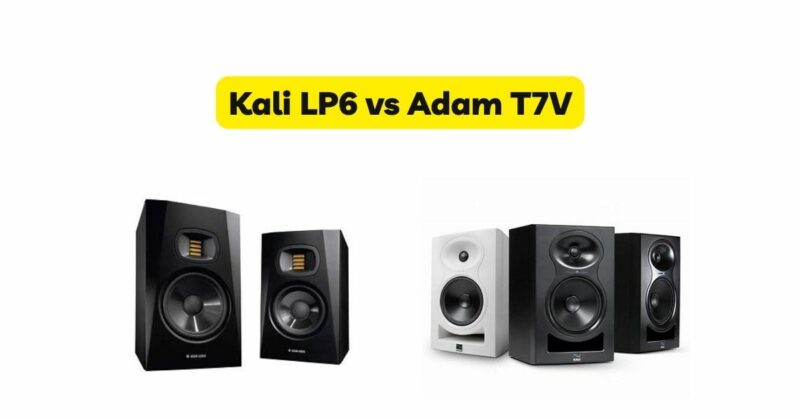Choosing the right studio monitors is crucial for achieving accurate and detailed sound reproduction in audio production. In this comprehensive comparison, we will explore the features, performance, design, and sonic characteristics of two popular active studio monitors: the Kali LP6 and the Adam T7V. By examining their specifications and evaluating their sound profiles, we aim to provide you with valuable insights to make an informed decision when selecting between the Kali LP6 and the Adam T7V for your studio setup.
Design and Build Quality
Both the Kali LP6 and the Adam T7V exhibit excellent build quality and thoughtful design elements, ensuring reliable performance and longevity.The Kali LP6 features a sleek and modern design with a matte black finish. It boasts a 6.5-inch woofer made of woven Kevlar, providing a balanced and accurate low-frequency response. The monitor also incorporates a 1-inch soft-dome tweeter, enabling detailed and smooth high-frequency reproduction. The LP6’s cabinet is constructed from MDF (Medium-Density Fiberboard), which minimizes resonances and vibrations, resulting in cleaner and more transparent sound reproduction. Additionally, the LP6 features rear-firing bass ports that optimize low-frequency extension and reduce port noise. The Adam T7V showcases a robust and professional design. It features a 7-inch polypropylene woofer that delivers tight and controlled bass response. The monitor also includes a U-ART accelerated ribbon tweeter, known for its exceptional transient response and extended high-frequency detail. The T7V’s cabinet is constructed from high-quality MDF and incorporates a front-firing bass reflex port for enhanced low-frequency performance and flexibility in speaker placement.
Sound Performance
The sound performance of the Kali LP6 and the Adam T7V emphasizes their respective driver technologies, amplifier designs, and overall sonic characteristics.The Kali LP6 provides a balanced and accurate sound reproduction suitable for various audio production tasks. With a frequency response of 39Hz to 25kHz, the LP6 captures a wide range of frequencies with precision. The monitor’s Class D amplifier, combined with its DSP (Digital Signal Processing) control, ensures optimal performance and a linear frequency response. The LP6’s low-frequency reproduction is clean and well-defined, while the high-frequency response is detailed and smooth, allowing for critical monitoring and precise sound shaping.In comparison, the Adam T7V delivers a dynamic and transparent sound experience. With a frequency response of 39Hz to 25kHz, the T7V captures a similar frequency range to the LP6. The monitor’s Class D amplifier provides ample power and headroom, enabling accurate and detailed sound reproduction across the frequency spectrum. The T7V’s high-frequency performance, driven by the U-ART ribbon tweeter, is renowned for its clarity and transient response, making it ideal for critical listening and mixing tasks.
Features and Connectivity
Both the Kali LP6 and the Adam T7V offer a range of features and connectivity options that enhance their versatility and compatibility with various studio setups.The Kali LP6 includes rear-panel controls for adjusting the monitor’s sound to suit your listening environment. These controls include volume control, low and high-frequency trim switches, and a boundary EQ switch for optimizing the speaker’s response based on placement. The LP6 provides XLR, TRS, and RCA inputs, ensuring compatibility with a wide range of audio interfaces and devices.The Adam T7V features rear-panel controls for adjusting the monitor’s sound to accommodate different room acoustics. These controls include volume control, high-frequency and low-frequency shelving filters, and a +/- 2dB input level switch. The T7V offers XLR and RCA inputs, providing flexibility in connectivity options.
Conclusion
In conclusion, both the Kali LP6 and the Adam T7V offer exceptional performance and value in the realm of active studio monitors. The Kali LP6 delivers a balanced and accurate sound reproduction, making it suitable for critical monitoring and precise sound shaping. The Adam T7V provides a dynamic and transparent sound experience, ideal for critical listening and mixing tasks. Consider your specific audio production needs, desired sound signature, and budget when choosing between the two. Ultimately, both the Kali LP6 and the Adam T7V will elevate your studio monitoring capabilities and enhance your audio production workflow.


